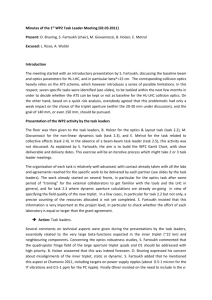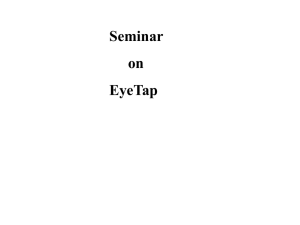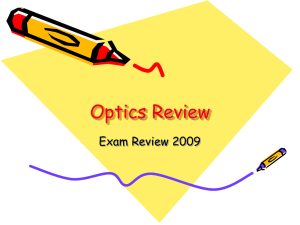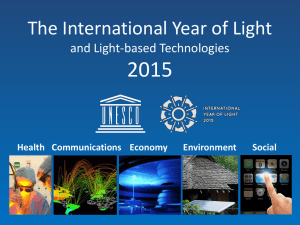HL-LHC optics S. Fartoukh, CERN-BE-ABP
advertisement
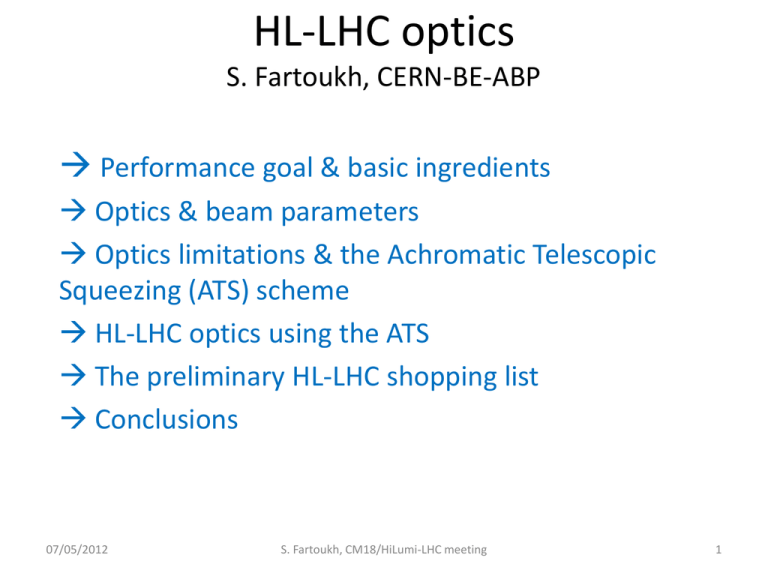
HL-LHC optics S. Fartoukh, CERN-BE-ABP Performance goal & basic ingredients Optics & beam parameters Optics limitations & the Achromatic Telescopic Squeezing (ATS) scheme HL-LHC optics using the ATS The preliminary HL-LHC shopping list Conclusions 07/05/2012 S. Fartoukh, CM18/HiLumi-LHC meeting 1 Performance goal & basic ingredients L = 3000 fb-1 from 2022-2023 to 2035 250 fb-1 / year (estimated to 150 days of operation) heff 40% machine efficiency required running at a levelled luminosity of Llev = 5 × 1034 Long fill required ( 10h including decay) compared to average turn around (estimated to 5h for LHC) to push heff Ingredients: Ideal case, F. Zimmerman 1. Higher current (× 1.5 × 1.9) first for beam life time. 2. Smaller emittance (÷1.25 ÷1.5) for “virtual luminosity”. 3. Smaller b* (÷4 ÷12) for “virtual luminosity”. 4. Crab-cavity (or flat optics with shorter bunch length) for “virtual luminosity”. 07/05/2012 S. Fartoukh, CM18/HiLumi-LHC meeting 2 Baseline Optics & Beam Parameters LHC nominal HL-LHC 25 ns HL-LHC 50 ns 2808 2808 1404 1.15 (0.58A) 2.2 (1.11 A) 3.5 (0.88 A) gex,y [mm] 3.75 2.5 3.0 eL [eV.s] 2.5 2.5 2.5 sz [cm] 7.5 7.5 7.5 sdp/p [10-3] 0.1 0.1 0.1 b* [cm] 55 15 15 285 (9.5 s) 590 (12.5 s) 590 (11.4 s) Lumi loss factor 0.84 0.30 0.33 Peak lumi [1034] 1.0 7.2 8.3 1.2 21.7 23.1 Tleveling [h] @ 5E34 n/a 8.9 7.3 #Pile up @5E34 25 123 247 # Bunches p/bunch [1011] X-angle [mrad] Virtual lumi [1034] Latest HL-LHC beam parameters worked out by O. Brüning 25 ns is the baseline, 50 ns is a back-up (e.g. for e-cloud). Full agreement not yet reached with the LHC Injector Upgrade project (e.g. 3 mm offered instead of 2.5 mm emittance for the 25 ns case, but 2.2E11 bunch charge possibly reachable!) (with hour-glass effect) Heavily relies on crab-cavity with a bare minimum of 10 MV / beam/ IR side. Prepare variants for the HL-LHC optics with even smaller b* and/or flat optics (back-up in the absence of crab-cavity) 07/05/2012 S. Fartoukh, CM18/HiLumi-LHC meeting 3 Optics Parameters (baseline & variants) Optics parameters “Baseline-HL” “Stretched-HL” Injection @ 450 GeV b* [m] 5.5 5.5 Full Xangle [mrad] 490 490 2 2 Half-parallel separation [mm] Collision round @ 7 TeV (X-angle set to 12.5s at 2.5 mm emittance) b* [m] 0.15 0.10 Full Xangle [mrad] 590 720 Collision flat @ 7 TeV (crossing in the plane of biggest b*, set to 16.5 s at 2.5 mm emittance) b* [m] (aspect ratio of 4 found optimal for aperture) Full Xangle [mrad] 0.30/0.075 0.20/0.05 550 670 All these optics are now available in the latest optics & layout version of the HL-LHC: SLHCV3.1b (150 T/m-140 mm Nb3Sn IT) 07/05/2012 S. Fartoukh, CM18/HiLumi-LHC meeting 4 A small digression: Why more than 10s for the X-angle ? Tune footprint at 6s with 21 LR’s per IP side (longer IT), HO at IP1 and IP5, b*=15 cm and beam parameters (higher bunch charge) given in the previous table 25 ns, 10s (475 mrad) 50 ns, 10s (520 mrad) 25 ns, 590 mrad (12.5s) 07/05/2012 S. Fartoukh, CM18/HiLumi-LHC meeting 50 ns, 590 mrad (11.4s) 5 100’000 turns DA simulation results vs. X-angle confirming the “pathological tune footprint” (25 ns beam parameters, b*=15 cm, only sextupoles, LR and HO, no crabcrossing no field imperfection) Preliminary results from S. White 07/05/2012 S. Fartoukh, CM18/HiLumi-LHC meeting 6 Optics Limitations & the ATS scheme (1/2) Lowering b* needs magnets of larger aperture, but also new hardware or sophistication (crab-cavity, flat optics,...) to mitigate the luminosity loss due to the Piwinsky angle. How to produce this b* ??? This is the aim of the ATS scheme which solves many optics limitations coming from the overall LHC ring. 1. Optics matchability to the arcs: – Some IR quads going to 0 T/m, others to max. field (200T/m). – Simply the matching section becomes too short at some point. 2. Correctability of the chromatic aberrations induced, not only Q’, but also Q’’, Q’’’,…, and off-momentum b-beating: – limitations from the arc sextupole strength (<600A). ... Otherwise b* would be limited to 30 (25) cm with the NbTi (Nb3Sn) technology and indeed 120 mm would be optimum for the IT aperture !!! 07/05/2012 S. Fartoukh, CM18/HiLumi-LHC meeting 7 Optics Limitations & the ATS scheme (2/2) • A new injection optics (p/2 FODO lattice new integer tunes) • A squeeze in 2 steps 1) An “almost” standard squeeze, the Pre-squeeze: acting on the matching quads of IR1 and IR5, with new matching constraints on the left/right IR phase till reaching some limits (sextupoles, matching quadrupoles). 2) A further reduction of b*, the Squeeze: acting on IR2/8 for squeezing IR1 and IR4/6 for IR5, inducing b-beating bumps in sectors 81/12/45/56 to boost the sextupole efficiency at constant strength. b * Squeeze b * Pre Squeeze (bˆ ) (bˆ ) Arc FODO Arc Mismatched 07/05/2012 S. Fartoukh, CM18/HiLumi-LHC meeting 8 HL-LHC optics using the ATS (1/8) Injection optics b* = 5.5 m at IP1 and IP5 (150 T/m IT gradient) 07/05/2012 S. Fartoukh, CM18/HiLumi-LHC meeting 9 HL-LHC optics using the ATS (2/8) Pre-squeezed optics b* = 40 cm at IP1 and IP5 (150 T/m IT gradient) 07/05/2012 S. Fartoukh, CM18/HiLumi-LHC meeting 10 HL-LHC optics using the ATS (3/8) Round Squeezed optics b* = 10 cm at IP1 and IP5 (150 T/m IT gradient) 07/05/2012 S. Fartoukh, CM18/HiLumi-LHC meeting 11 HL-LHC optics using the ATS (4/8) Flat Squeezed optics b* = 20/5 cm at IP1 and IP5 (150 T/m IT gradient) bmax= 55 km a factor of 12 above nominal! 07/05/2012 S. Fartoukh, CM18/HiLumi-LHC meeting 12 Why does it work? The magic lies in the choice of the betatron phases .. Zoom in arc45: Pre-Squeeze to b*= 40/40 cm (round optics) Dmy p between strong SD’s (every other FODO cells) Dmx p between strong SF’s (every other FODOcells) Dmy (Q11 IP ) = 1.25×p + ey with ey ~ 1/2 tan-1 (bmin/bmax) (barc× b *)V cst Dmx(Q10 IP ) = 0.75×p + ex with ex ~ - 1/2 tan-1 (bmin/bmax) (barc× b *)H cst p/2 phase in the arc cells p/2 on the left/right side of the IR 2 sextupole families per plane but only one used for triplet correction IR4 (RF insertion) 07/05/2012 S. Fartoukh, CM18/HiLumi-LHC meeting IR5 (CMS insertion) 13 Why does it work? The magic lies in the choice of the betatron phases .. Zoom in arc45: Squeeze to b*= 10/10 cm (round optics) Dmy p between strong SD’s (every other FODO cells) Dmx p between strong SF’s (every other FODOcells) IR4 (RF insertion) 07/05/2012 S. Fartoukh, CM18/HiLumi-LHC meeting Dmy (Q11 IP ) = 1.25×p + ey with ey ~ 1/2 tan-1 (bmin/bmax) (barc× b *)V cst Dmx(Q10 IP ) = 0.75×p + ex with ex ~ - 1/2 tan-1 (bmin/bmax) (barc× b *)H cst IR5 (CMS insertion) 14 Why does it work? The magic lies in the choice of the betatron phases .. Zoom in arc45: Squeeze to b*= 20/5 cm (flat optics) Dmy p between strong SD’s (every other FODO cells) Dmx p between strong SF’s (every other FODOcells) IR4 (RF insertion) 07/05/2012 S. Fartoukh, CM18/HiLumi-LHC meeting Dmy (Q11 IP ) = 1.25×p + ey with ey ~ 1/2 tan-1 (bmin/bmax) (barc× b *)V cst Dmx(Q10 IP ) = 0.75×p + ex with ex ~ - 1/2 tan-1 (bmin/bmax) (barc× b *)H cst IR5 (CMS insertion) 15 Simulating the ATS in the existing LHC (IT @ 205 T/m) to deliver b*= 10 cm at IP1&5 Tunes vs. dp IR4 IR5 IR6 Beam size [mm] and dispersion (IR4IR6) at 3.5 TeV (for ge=3.5 mm) 07/05/2012 S. Fartoukh, CM18/HiLumi-LHC meeting Chromatic Montague functions over the full ring (off-momentum b-beating) 16 HL-LHC optics using the ATS (5/8) The new crossing bump is closed at D2 before the crab-cavity, but requires 1. strong 2-in-1 orbit corrector at D2 in the X-plane: 105 mm, 7 Tm 2. strong single bore orbit corrector on the nIP side of Q3: 140-150 mm, 4-5 Tm Idea from R. de Maria Standard crossing scheme (closing at Q6) 07/05/2012 New crossing scheme (closing at D2) S. Fartoukh, CM18/HiLumi-LHC meeting 17 HL-LHC optics using the ATS (6/8) An additional functionality of the ATS optics: Correcting the huge spurious dispersion induced by the X-angle ATLAS LHCb CMS Alice Up to 15-20 m of spurious dispersion in the IT @ b*=10 cm! H & V Dispersion Closed orbit Correction to less than 1m via modest orbit bumps in the arcs 07/05/2012 S. Fartoukh, CM18/HiLumi-LHC meeting 18 HL-LHC optics using the ATS (7/8) Mechanical aperture: the largest is the better (“1 mm much more valuable than 1 T/m”) Courtesy, R. De Maria Target of 14s at 7 TeV extrapolated at constant collimator & protection settings (in mm) from the present operation @ 4TeV. Target of 11.5s assuming new hardware (1-2 s less might even be OK ... being worked out in WP5): BPM at collimator (R. Assmann, R. Bruce, S. Redaelli et al.) and/or more robust TCTH ( for IT protection against asynchronous dump). Two cases showed: 140 mm IT/D1 with b*= 15 cm and 150 mm IT/D1 with b*= 10 cm Brute aperture, i.e. with no budget for CO, spurious dispersion, b-beating,... No beam-screen assumed in the IT/D1 but very thick cold bore (10 mm) for shielding New TAS, TAN, D2, Q4, Q5 (see later for the first aperture specification) 07/05/2012 S. Fartoukh, CM18/HiLumi-LHC meeting 19 HL-LHC optics using the ATS (8/8) Dynamic aperture see talk by Y. Cai on Tuesday afternoon ...the good field region is as important as the available aperture ... “good” means IT harmonics of a few 10-5 at 7 TeV to be compatible with the b* range of HL-LHC! In this respect, we should first convince ourselves that the Nb3Sn technology is the right choice for HL-LHC. demonstrate rapidly that the 0.5-1 unit FQ level (at 2/3 of the aperture) is within reach at 7 TeV, with good hope for further improvement (keeping in mind that the requirements at 450 GeV are much less stringent, e.g. 20-30 units of b6 at Rr=50 mm). keep in mind the 0.5 TeV uncertainty for the final energy of the LHC within which the FQ (e.g. b6) shall ideally not deviate by more than 0.1-0.2 unit w.r.t. 0. 07/05/2012 S. Fartoukh, CM18/HiLumi-LHC meeting 20 The preliminary HL-LHC shopping list 1. HW re-commissioning & modifications needed for the ATS - Re-commission at 600A the 16 SD families of sectors 81/12/45/56 - equip the 4 Q10’s of IR1/5 with an arc MSCB (sextupole + orbit corrector) instead of MCBC - replace Q5 in IR6 (MQY type, 3.2 m ×160 T/m) by a longer magnet (MQYL, e.g. 4.8 m ×160 T/m) 2. The main shopping list for LSS1 and LSS5 (corrector not included) Equipment TAS IT Aperture [mm] Separation [mm] (for 2-in-1) Performance (T/m, T.m, MV,...) 60 n/a n/a 140150 (w/o beam- n/a 150 T/m 100 T/m n/a 35 T.m 40 T.m (depending on IT screen but shielding) D1 140150 (more might be needed for beam-screen) length, i.e. on IT gradient) TAN 41/37 (elliptical) 145 n/a D2 105 186 35 T.m 40 T.m Crab-cavity 80 194 10 MV per beam, per IR side Q4 90 194 500 T/m×m Q5 70 194 750 T/m×m 07/05/2012 S. Fartoukh, CM18/HiLumi-LHC meeting (+2.5MV to be fully compatible with b*=10cm) 21 Conclusions Work already very well-advanced, but as usual devil is in the details. The field quality of the IT looks extremely challenging to fully profit from the large IT aperture (and from the ATS) The crab-cavity voltage shall be pushed as much as we can if one hopes to fully profit from b*= 15 cm, if not 10 cm. ... and first ATS machine experiments cannot be more encouraging! ATS experiments at the LHC, S. Fartoukh et al. at IPAC’12 After a single shift, a factor of only 2 was missing to demonstrate the HL-LHC b*! 07/05/2012 S. Fartoukh, CM18/HiLumi-LHC meeting 22 ... Reserve 07/05/2012 S. Fartoukh, CM18/HiLumi-LHC meeting 23 What would happen for a “standard squeeze” to b*= 30 cm (120 T/m triplet) ? 550A 160 T/m Transition @ b*=1.5 m b*=30 cm Q5/Q6 close to 0! Matching section (MS) 07/05/2012 b*=30 cm 550A! - 550A Sextupole powering scheme and gradients (beam1) at 7 TeV vs. b* S. Fartoukh, CM18/HiLumi-LHC meeting 24 Typical settings [A] at 3.5 TeV for the sextupole families (Beam1) testing the ATS in the LHC b*> 40 cm 10 cm < b*< 40 cm During the telescopic part, the chromatic correction is achieved by the b-beating! Only 25% of the RS circuits participates to the chromatic correction during the pre-squeeze All sextupole then kept ~ constant during the squeeze: THERE IS NO CHROMATIC LIMIT! 07/05/2012 S. Fartoukh, CM18/HiLumi-LHC meeting 25
